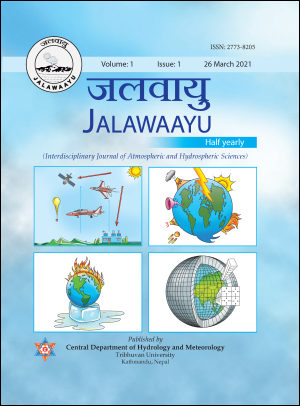Changing Ecological and Hydrological Conditions in the Himalayan Mountains and Measures of Future Adaptation
DOI:
https://doi.org/10.3126/jalawaayu.v1i1.36447Keywords:
Ecohydrology, Rivers, Lakes, Mountains, HimalayasAbstract
The Himalayan mountains are one of the important geographical settings of the planet Earth for the source of global freshwaters. The freshwaters from the Himalayas are life supporting systems of the millions of people residing in downstream Asia. However, the high-altitude mountains of the Himalayas have gone through considerable transformations in hydrology and ecology over the recent past. In the 21st century, the hydrological flow regimes of glacial-fed rivers are threatened by both climate change and human disturbances. Rapidly changing temperature and the frequency, duration and timing of monsoonal precipitation have altered glacier melt, river flow, flood, and downstream volume of water. As a result, the ecosystems and biodiversity as well as irrigation-dependent agriculture in the region is profoundly impacted. The fundamental challenge today is therefore to address the issue of water resources through understanding of hydrological and ecological changes of lake and river systems in the region. Ecohydrology is a sustainability concept, which addresses water resource management through understanding of water cycle, including hydrological processes of rivers and lakes and the structure, and function of ecosystems. Putting ecohydrology at the center of the water resource management program, this mini review discusses rapid ecological and hydrological changes of freshwater systems in the Himalayan mountains and suggested some of the key future adaptation strategies of water resources to rapidly changing regional environment.
Downloads
Downloads
Published
How to Cite
Issue
Section
License
Copyright © of the articles is held by the authors.

